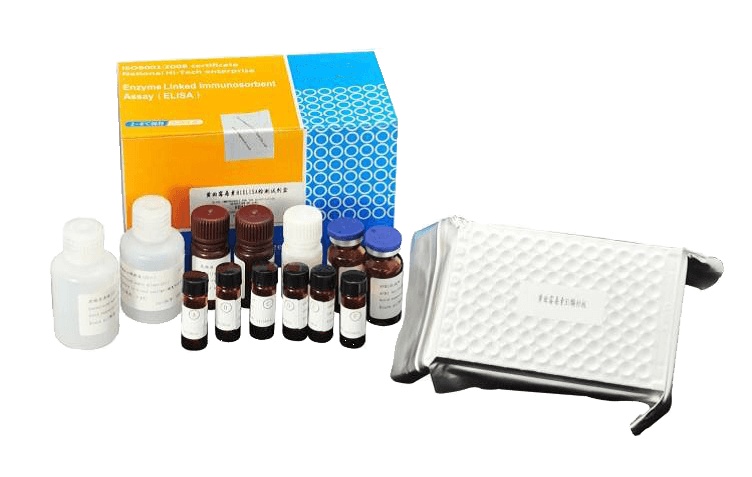PROPERTIES
Chloramphenicol is an antibiotic useful for the treatment of a number of bacterial infections.
The most serious side effect of chloramphenicol treatment is aplastic anaemia. This effect is rare and is generally fatal.
PRODUCT DESCRIPTION
Product Name: ChloramphenicolELISA Kit
Specification: 96T
Storage Condition: 2-8°C
Restriction: For resaerch use only!
Summary
Chloramphenicol is an antibiotic useful for the treatment of a number of bacterial infections.
The most serious side effect of chloramphenicol treatment is aplastic anaemia. This effect is rare and is generally fatal.
Use Principles
Chloramphenicol ELISA Kitis an indirect competitive enzyme-labeled immunoassay. The Chloramphenicol antigen is precoated on the wells. The precoated antigen compete the Chloramphenicol antibody (antibody solution) with Chloramphenicol in the sample, anti- Chloramphenicol antibody binds to the Chloramphenicol-HRP enzyme conjugate. Then pipet the substrate solutions to the wells to convert the color.
The color of unknown samples is compared to the color of the standards and the Chloramphenicol concentration of the samples is derived.
Scope of Application
Qualitative or quantitative analysis the residues of Chloramphenicol in honey, milk, feed, egg, tissues (including aquatic products), etc.
TECHNICAL SPECIFICATIONS
Cross-reactivity
Chloramphenicol…………………………………………………100%
Florfenicol…………………………………………………<0.01%
Provided Materials and Reagent
| Component | 96 wells |
| Antigen coated plate | 12 test strips of 8 wells each |
| 6 vials of standard | 1.5ml each |
| High Concentrated Standard (100ppb) | 1.5ml |
|
HRP-conjugate |
6ml |
| Antibody Solution | 4ml |
| Substrate A | 6ml |
| Substrate B | 6ml |
| Stop Solution | 6ml |
| Concentrated Sample Extraction Solution | 40ml |
| Concentrated Wash Buffer (10×) | 40ml |
| Concentrated redissolving solution | 40ml |
| IFU | 1 |
| Testing Report | 1 |
Sensitivity, accuracy and precision
Sensitivity: 0.01ppb
Limit of detection
Tissue……………………………………………………………………………………………0.02ppb
Dairy……….…………………………………………………………………………………….0.02ppb
Fresh Milk……………………………………………….………………………………………0.04ppb
Milk Powder….…………………………………………………………………………………0.02ppb
Feed….……………………………………………………………………. …….……………0.04ppb
Egg….………………………………………………………………………………………..…0.02ppb
Honey….………………………………………….……………………………………………0.02ppb
Royal jelly….……………………………….…….……………………………………………0.02ppb
Percent Recovery, %
Tissue…………………………………………………………………………………………80±10%
Dairy……….………………………………………………………………………………..…80±10%
Fresh Milk……………………………………………….………………………………….…80±10%
Milk Powder….……………………………………………………………………………..…80±10%
Feed….……………………………………………………………………. …….……………80±10%
Egg….………………………………………………………………………………………..…80±10%
Honey….………………………………………….……………………………………….……80±10%
Royal jelly….……………………………….…….……………………………………….……80±10%
Precision (CV %):
Intra-lab assay: CV%≤10%
READ INSTRUCTION MUNUAL COMPLETELY BEFORE USE!
1. Take out the reagents from the refrigerator and allow them to reach room temperature (20 to 25°C ) prior to running the test. Shake up the reagents before use.
2. Place the appropriate number of test wells into a microwell holder. Be sure to re-seal unused wells in the zip-lock bag with desiccant stored under the temperature 2-8°C (Do not freeze).
3. Numbering: Number the microwells for the standards and samples separately. Running standards and samples in duplicate.
4. Using a pipette with disposable tips, add 70 μl of standards and samples to the appropriate test wells. Be sure to use a clean pipet tip for each. Then dispense 50 µl HRP-conjugate and 30 µl antibody solution into each test well in order.
5. Shake the plate gently to mix contents, cover the plate rack and incubate the test wells at 25°C keeping away from light for 30 minutes.
6. Open the cover on the plate and dump the contents of the wells into an appropriate waste container. Fill the wells to overflowing with wash buffer and dump (300µL each well). Repeat for a total of four washes (wait 30s between each wash). Following the last wash, tap the inverted wells onto absorbent paper to remove the last of the wash buffer.
7. Dispense 50µL Substrate A and 50µL Substrate B into each well in order. Shake the plate gently. Cover the plate rack and incubate the wells at 25°C for 15 minutes.
8. Dispense 50 µL of stop solution into each test well. Shake the plate rack gently to mix.
9. Read and record the absorbance of the wells at 450nm using a plate reader (dual wavelength 450/630nm detecting is advised) within 5 minutes.



